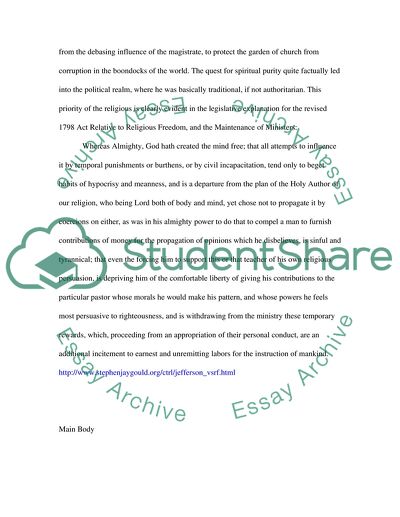Cite this document
(“Separation of Church and State Essay Example | Topics and Well Written Essays - 4250 words”, n.d.)
Separation of Church and State Essay Example | Topics and Well Written Essays - 4250 words. Retrieved from https://studentshare.org/politics/1536501-8it-seems-highly-paradoxical-that-the-united-states-constitution-provides-for-a-strict-separation-of-church-and-state-yet-religious-considerations-have-a-major-impact-on-the-countrys-public-life-discuss
Separation of Church and State Essay Example | Topics and Well Written Essays - 4250 words. Retrieved from https://studentshare.org/politics/1536501-8it-seems-highly-paradoxical-that-the-united-states-constitution-provides-for-a-strict-separation-of-church-and-state-yet-religious-considerations-have-a-major-impact-on-the-countrys-public-life-discuss
(Separation of Church and State Essay Example | Topics and Well Written Essays - 4250 Words)
Separation of Church and State Essay Example | Topics and Well Written Essays - 4250 Words. https://studentshare.org/politics/1536501-8it-seems-highly-paradoxical-that-the-united-states-constitution-provides-for-a-strict-separation-of-church-and-state-yet-religious-considerations-have-a-major-impact-on-the-countrys-public-life-discuss.
Separation of Church and State Essay Example | Topics and Well Written Essays - 4250 Words. https://studentshare.org/politics/1536501-8it-seems-highly-paradoxical-that-the-united-states-constitution-provides-for-a-strict-separation-of-church-and-state-yet-religious-considerations-have-a-major-impact-on-the-countrys-public-life-discuss.
“Separation of Church and State Essay Example | Topics and Well Written Essays - 4250 Words”, n.d. https://studentshare.org/politics/1536501-8it-seems-highly-paradoxical-that-the-united-states-constitution-provides-for-a-strict-separation-of-church-and-state-yet-religious-considerations-have-a-major-impact-on-the-countrys-public-life-discuss.


